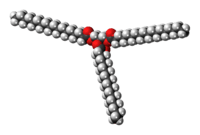Stearin
 | |
 | |
| | |
| Names | |
|---|---|
| IUPAC name
1,3-Di(octadecanoyloxy)propan-2-yl octadecanoate | |
| Other names
Tristearin; Trioctadecanoin; Glycerol tristearate; Glyceryl tristearate | |
| Identifiers | |
| 555-43-1 | |
| ChEBI | CHEBI:45956 |
| ChemSpider | 10673 |
| |
| Jmol-3D images | Image |
| PubChem | 11146 |
| |
| Properties | |
| Molecular formula |
C57H110O6 |
| Molar mass | 891.48 g·mol−1 |
| Appearance | White powder |
| Odor | Odorless |
| Density | 0.862 g/cm3 (80 °C) 0.8559 g/cm3 (90 °C)[2] |
| Melting point | 54–72.5 °C (129.2–162.5 °F; 327.1–345.6 K) [3] |
| Insoluble | |
| Solubility | Slightly soluble in C6H6, CCl4 Soluble in acetone, CHCl3 Insoluble in EtOH[2] |
| Refractive index (nD) |
1.4395 (80 °C)[2] |
| Structure | |
| Crystal structure | Triclinic (β-form)[4] |
| Space group | P1 (β-form)[4] |
| Lattice constant | a = 12.0053 Å, b = 51.902 Å, c = 5.445 Å (β-form)[4] |
| Lattice constant | α = 73.752°, β = 100.256°, γ = 117.691° |
| Thermochemistry | |
| Specific heat capacity (C) |
1342.8 J/mol·K (β-form, 272.1 K) 1969.4 J/mol·K (346.5 K)[3][5] |
| Std molar entropy (S |
1534.7 J/mol·K (liquid)[5] |
| Std enthalpy of formation (ΔfH |
−2344 kJ/mol[5] |
| Std enthalpy of combustion (ΔcH |
35806.7 kJ/mol[5] |
| Hazards | |
| NFPA 704 | |
| Flash point | ≥ 300 °C (572 °F; 573 K) closed cup[6] |
| LD50 (Median lethal dose) |
2000 mg/kg (rats, oral)[6] |
| Except where noted otherwise, data is given for materials in their standard state (at 25 °C (77 °F), 100 kPa) | |
| | |
| Infobox references | |
Stearin /ˈstɪərɨn/, or tristearin, or glyceryl tristearate is a triglyceride derived from three units of stearic acid. Most triglycerides are derived from at least two and more commonly three different fatty acids.[7] Like other triglycerides, stearin can crystallise in three polymorphs. For stearin, these melt at 54 (α-form), 65, and 72.5 °C (β-form).[3]
Occurrence
Stearin is obtained from animal fats created as a byproduct of processing beef. It can also be found in tropical plants such as palm. It can be partially purified by "dry fractionation" by pressing tallow or other fatty mixtures, leading to separation of the higher melting stearin-rich material from the liquid, which is typically enriched in fats derived from oleic acid. It can be obtained by "interesterification", again exploiting its higher melting point which allows the higher melting tristearin to be removed from the equilibrated mixture. Stearin is a side product obtained during the extraction of cod liver oil removed during the chilling process at temperatures below −5 °C.
Uses
It is used as a hardening agent[8] in the manufacture of candles and soap. In the manufacture of soap, stearin is mixed with a sodium hydroxide solution in water. The following reaction gives glycerin and sodium stearate, the main ingredient in most soap:
- C3H5(C18H35O2)3 + 3 NaOH → C3H5(OH)3 + 3 C17H35COONa
Stearin is also used in conjunction with aluminium flakes to help in the grinding process in making dark aluminium powder.
See also
- Michel Eugène Chevreul
- Soap making
- Stearic acid
- Candle
References
- ↑ Merck Index, 11th Edition, 9669.
- ↑ 2.0 2.1 2.2 Lide, David R., ed. (2009). CRC Handbook of Chemistry and Physics (90th ed.). Boca Raton, Florida: CRC Press. ISBN 978-1-4200-9084-0.
- ↑ 3.0 3.1 3.2 Charbonnet, G. H.; Singleton, W. S. (1947). "Thermal properties of fats and oils". Journal of the American Oil Chemists Society 24 (5): 140. doi:10.1007/BF02643296.
- ↑ 4.0 4.1 4.2 Van Langevelde, A.; Peschar, R.; Schenk, H. (2001). "Structure of β-trimyristin and β-tristearin from high-resolution X-ray powder diffraction data". Acta Crystallographica Section B Structural Science 57 (3): 372. doi:10.1107/S0108768100019121.
- ↑ 5.0 5.1 5.2 5.3 Tristearin in Linstrom, P.J.; Mallard, W.G. (eds.) NIST Chemistry WebBook, NIST Standard Reference Database Number 69. National Institute of Standards and Technology, Gaithersburg MD. http://webbook.nist.gov (retrieved 2014-06-19)
- ↑ 6.0 6.1
- ↑ Alfred Thomas (2002). "Fats and Fatty Oils". Ullmann's Encyclopedia of Industrial Chemistry. Ullmann's Encyclopedia of Industrial Chemistry. Weinheim: Wiley-VCH. doi:10.1002/14356007.a10_173. ISBN 3527306730.
- ↑ "Waxes in the candle industry".
| ||||||||||||||||||||||||||||||||
